It would have been a lot easier for Midpen’s board of directors to take the middle ground that was offered. The Midpeninsula Regional Open Space District (Midpen) was under considerable pressure from some members of the public to allow e-bikes on its 250 miles of trails. Pilots on paved trails in two of Midpen’s preserves had proven successful, feedback in those preserves and nearby parks seemed quite favorable for e-bikes, and public comment to the board had been in favor. A 130-page report summarizing several years of work evaluating e-bikes indicated little known impact to date from them, and in many ways they appeared to be indistinguishable from the mountain bikes that are already allowed on many preserve trails.
The Board was offered three choices: (a) Approve Class 1 e-bikes on all preserve trails that allow mountain bikes; (b) Continue to ban e-bikes on all trails, with possible exceptions for the two paved/improved pilot areas; or (c) Explore e-bikes on unpaved trails with a new pilot in one or two preserves. That middle ground can look awfully appealing. And yet the Midpen board voted 4-2 in favor of continuing to prohibit e-bikes in its preserves, with the exception of the paved/improved trails where successful pilots were conducted. They did not opt to conduct a new unpaved pilot. They just said “No”.
I was impressed. I think it’s the right decision, but I was not expecting it. How did it happen and what role did you (the public) play?
The general structure of the 5-hour board meeting where this decision was made was first to review the report (2.5 hours), then hear public comment (about 75 comments taking 1 hour), and finally hold a discussion among board members (another hour). I reviewed the report in the previous post, so I won’t go over it again here. I think it is fair to say that the board understood the constraints of the data that was collected and the limitations of the science on e-bike impact to date.
The public comment was interesting. Up until this board meeting, the large majority of public comment had been in favor of e-bikes on unpaved trails, with the main exception being a set of feedback from equestrians (70% opposed). But this meeting’s feedback was more balanced. There was still some assertive pro e-bike campaigning. Indeed, the board was threatened with accusations of NIMBY-ism, age-ism, and discrimination. Here is a sampling.
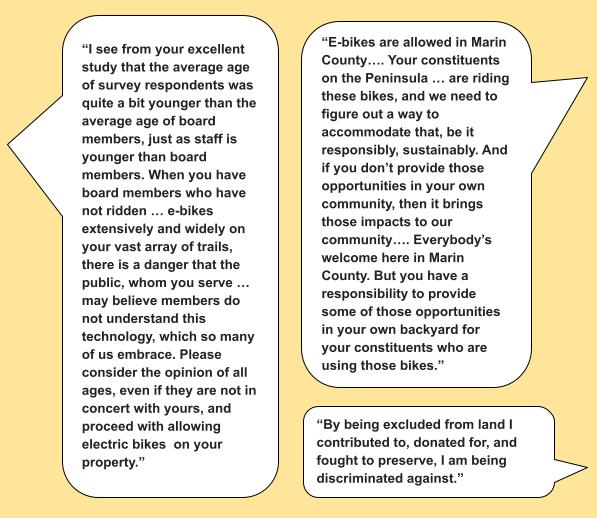
The largest set of pro e-bike feedback, however, came from seniors who wanted to extend their enjoyment of the preserves. Here is a sampling.
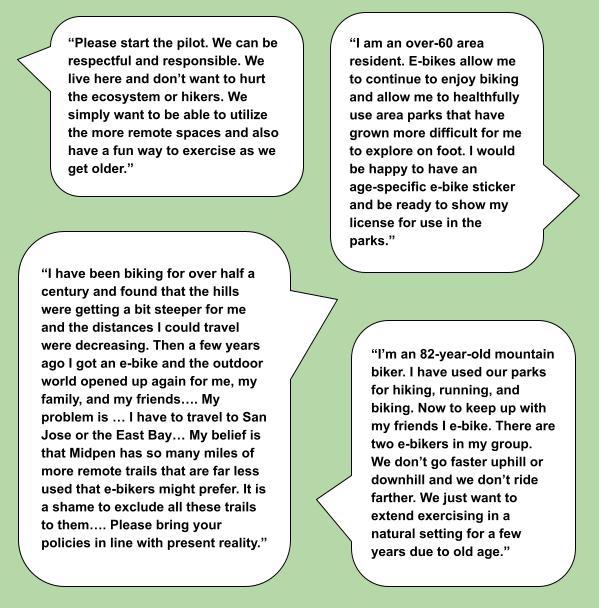
What made this meeting different from previous meetings was the volume of people who spoke out against e-bikes. As with the cyclists, many of them spoke out of self-interest, concerned with the disruption that e-bikes (and more bikes in general) would pose to them on trails. Some of those comments:
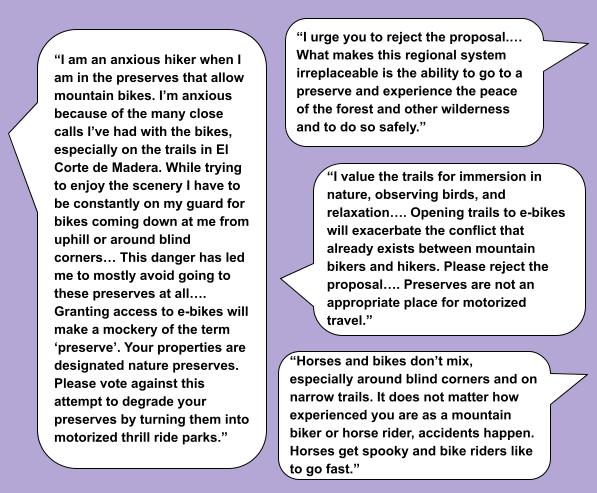
But many of the speakers opposed to e-bikes focused on the preserves themselves and the animals that live in them.
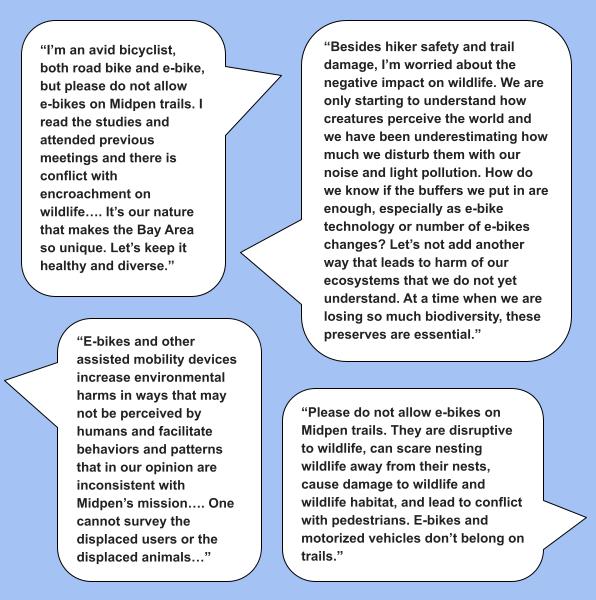
After public comment came the discussion among Midpen board members. They expressed appreciation for the public’s feedback and noted that they had also given this issue a lot of thought. Many cited the relevance of Midpen’s mission, which they referred to as “Preserve. Protect. Restore. Enjoy” in that order, with the latter being “environmentally-sensitive public enjoyment”. They were universally clear on this mission and how it distinguishes the preserves from a park. Board member Curt Riffle said he had also looked at the “basic policy” of Midpen and quoted from it: “The timing and level of access for low intensity public recreational use of district open space land will be evaluated in terms of four basic criteria. 1. Protection of natural resources. 2. Preservation of the opportunity for tranquil nature study and observation. 3. Avoidance of significant user conflicts. 4. Availability of board and/or staff time funding and/or means to plan and manage the use.” Riffle remarked “So if I go back to what is driving us, it’s our mission, it’s our basic policy, and to me that really spells it out.”
The board was not convinced by the many commenters who claimed that e-bikes are essentially indistinguishable from mountain bikes. Not only can some animals easily differentiate the two due to the high frequency noise from the batteries, but the people riding them clearly know the difference. The e-bike enthusiasts said that they could go up hills easier, they could go on trails that they wouldn’t otherwise be able to, they could go farther, they could bike instead of walk. The board accepted this, concluding that allowing e-bikes would mean more bikes on trails, more bike-miles on trails, and more impact farther into the preserves. Furthermore, they noted that it is early days for e-bikes. E-bikes will get more affordable and more powerful. The technology is evolving quickly, the adoption curve is steep, and the marketing is intensive. Riffle worried: “(If we admit e-bikes at this early stage), we’re at the mercy, if you will, of the bike industry. Because you bet they’re going to be much stronger, go farther, be more affordable. I think that what would happen is e-bikes would be the fastest growth segment of all of our user groups. I frankly think it would get out of control for us.” All but one of the Board members were inclined to go slow because of this. (Board member Pete Siemens felt they shouldn’t worry so much about allowing use that they might later revoke.)
The board members understood that Midpen’s outreach had been heavily skewed towards cyclists despite efforts from staff. Initially Midpen posted the e-bike program information only on the cycling page of their website. As a result feedback was largely from cyclists and organized cycling groups. Partway through the pilot program, Midpen staff made a concerted effort to reach out to the general public, posting it more prominently on their website and putting signs on the notice boards at the preserves. But it is not clear that people read them. The on-location survey feedback was also largely from cyclists in bike-intensive preserves and parks.
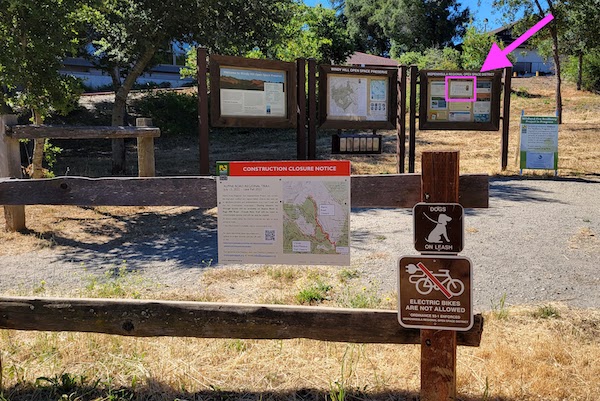
In case like me you never saw the notice about the e-bike evaluation, here’s where it was, at least at Windy Hill.
But it wasn’t only the mission, the fast-evolving technology, and the skewed input that weighed on the board’s decision. Board members also cited the stress that climate change is putting on the preserves and the threat it represents to the lands they have been given to protect. Board Chairwoman Zoe Kersteen-Tucker said it directly affects how she and other Board members think about these tradeoffs of access vs preservation. “Our job is to listen to the public. We are there to represent them. That being said, oftentimes the people who come and speak the loudest and are most organized are special interest groups. They are not coming with a broader perspective on the array of challenges that Midpen faces and deals with, especially in the face of changing climate. Speaking for myself and other board members, we think about that a lot.”
Many of us may not be aware that these areas we enjoy are preserves or understand what that means. Many years ago I was walking my dog in one of them and she stopped to dig on the edge of the trail. A ranger pulled up in his truck and pointed out that we were in a preserve and my dog’s digging wasn’t welcome. I was taken aback, initially annoyed, then kind of chastened. I had never really thought about what the word “preserve” meant, or that we might have to play second fiddle to the inhabitants. It reminded me of a time when I was backpacking in Glacier National Park and some trails were closed because it was huckleberry season and the bears wanted to graze there. It was an inconvenience for sure, and it seemed almost quaint to me, but I was glad that Glacier was doing it. I wish we could apply this humility to more of our interactions with the natural world. At minimum we should understand the charter of our local preserves. Kersteen-Tucker lauds the role that rangers play in that regard. “They are our ambassadors. Rangers are not about writing tickets and being mean. They focus on helping to build awareness through dialog.”
The Midpen board’s decision required backbone and principle. And it won’t be the last such decision. Kersteen-Tucker predicts “We will continue to see more pressure on our preserves with increased urbanization and more people wanting to enjoy the outdoors in more ways. This issue isn’t going away.” She encourages the public to participate, and emphasizes that it makes a difference. She reflected back to the role the public played in the Red Barn development discussion a few years ago, saying it changed the course of the project. She added that the public input on e-bikes, particularly from those with a clear understanding of Midpen’s mission, was “very persuasive to me”.
I am reminded of the Lorax introducing himself: "I am the Lorax. I speak for the trees. I speak for the trees as the trees have no tongues.” We can all be a voice for our natural lands and wildlife as climate change threatens their well-being. With intransigent parties crippling Congress, local action on climate change and biodiversity is more important than ever. Each of us can make a difference to preserve and enhance the natural world for all who live here. Stay informed and speak up.
Current Climate Data (May 2022)
Global impacts, US impacts, CO2 metric, Climate dashboard
Comment Guidelines
I hope that your contributions will be an important part of this blog. To keep the discussion productive, please adhere to these guidelines or your comment may be edited or removed.
- Avoid disrespectful, disparaging, snide, angry, or ad hominem comments.
- Stay fact-based and refer to reputable sources.
- Stay on topic.
- In general, maintain this as a welcoming space for all readers.



